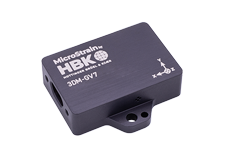 Combining wireless sensing with cloud technology enables easier collection and display of critical data.
Combining wireless sensing with cloud technology enables easier collection and display of critical data.
In the oil and gas drilling industry, access to real-time data is essential for making the best drilling decisions and avoiding unscheduled downtime. In above-ground drilling applications, the health of machinery and equipment is integral to the efficient extraction of oil and gas. Downtime due to unscheduled maintenance or part failure is an extraordinarily expensive occurrence that must be avoided.
Among the recent advancements in sophisticated data collection are wireless sensor networks (WSNs). These systems consist of a network of distributed sensors that remotely communicate with a computer or gateway to deliver information on equipment conditions. Sensor nodes measure and collect data on various environmental and mechanical conditions such as vibration, torque, strain, load, pressure, temperature, and humidity.
Real-time condition monitoring begins with reliable data aggregation. Traditionally, this meant implementing a hardwired sensing system. However, with the advent of low-power radios and low-cost computing technologies, wireless systems are enabling a new generation of easy-to-use, dependable monitoring solutions.
Unlike traditional hardwired sensing systems, WSNs are quickly installed in new and retrofit applications. More scalable wireless networks enable greater visibility into equipment performance while retaining the precise interdevice time synchronization required to ensure comparative measurement. Furthermore, deeper embedded low-power wireless sensors support more targeted monitoring on local points of interest without the hassle of wires or battery maintenance.
The application of scalable sensing systems results in bigger datasets. While big data can provide valuable insights, deriving meaningful indicators requires intensive processing. By coupling sensor networks with cloud technologies, the information gathered from wireless sensors can be more efficiently used, allowing an engineer to quickly distill raw values and detect deviations in performance or conditions before they manifest as problems. This enhanced access to real-time data can make the difference between unscheduled downtime and preemptive maintenance action.
Sensors plus the cloud
To make WSNs even more valuable to drilling operations, WSNs combined with cloud computing are delivering real-time data in a more usable, easily interpreted format. Cloud computing has changed how companies produce, consume, and share information. It has reduced barriers and costs associated with access to powerful computing capabilities previously reserved for expensive enterprise systems while allowing access to new tools and techniques that exceed enterprise system performance and scalability.
For the oil and gas industry, cloud computing makes it possible to process massive amounts of sensor data for the health- and condition-monitoring of assets associated with a high cost for downtime. What is crucial to the combination of these two technologies is taking the data gathered from the wireless sensors and delivered by the cloud and translating them into a format where users can quickly and easily derive actions to optimize performance and availability.
A new sensor data aggregation platform, SensorCloud from LORD MicroStrain Sensing Systems, transitions these new cloud capabilities into tools that make it easier to collect and visualize large quantities of sensor data and extract meaningful insight with user-programmable online analytics. SensorCloud uses WSNs in the drilling environment to provide automated real-time condition alerts to operators and maintenance engineers via any web-connected device including computers, tablets, and mobile phones.
Making data usable
While cloud computing and WSNs are not uncommon to the drilling environment, having them work together to provide actionable feedback is something new for the industry.
It is not enough to merely put a sensor node on a piece of equipment. The information gathered from that sensor must be refined to a clear message that can be understood by maintenance personnel and drilling operators. Similarly, analytical and reporting tools are most effective when they are decoupled from unstructured interventions. Leveraging end-to-end sensing systems for surface equipment in the oil and gas industry enables automated information delivery in a format controlled by the end user.
With the new system there is no need for a direct connection to the wireless network. Information is relayed from the wireless network to the cloud (Internet), and all data are stored on a remote, secure server. The data are accessible anywhere, anytime. Condition-based monitoring also can be done in the cloud. A threshold can be established for a particular criteria or maintenance formula, and the system will alert appropriate personnel when that threshold has been reached.
One of the benefits of having real-time data available in a usable format is a reduction in maintenance costs and downtime. As a result, replacement parts can be delivered early, and replacements can be made on an optimized, preemptive maintenance schedule, saving operators time and money that would have been spent replacing parts too early or too late.
A feature unique to SensorCloud is MathEngine, an integrated development environment for analytics. This environment allows users to build and run custom algorithms on the cloud next to their data. With initial input from the user, the system will automatically and continually process data under any parameter required for monitoring purposes.
With this environment, the technology becomes a smart, autonomous system that translates and distills data into a user-selectable indicator of performance or health. Based on these indicators, the data can be used to justify and initiate preemptive and preventive action to optimize the health and usage of machines while ensuring the safety and well-being of workers.
WSNs combined with cloud computing make it easier to collect and display the data needed to make real-time decisions. This technology provides real-time data in a usable format to monitor the health and condition of valuable machinery. For the oil and gas industry these real-time data are an effective tool for increasing drilling efficiency and decreasing downtime.










